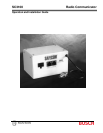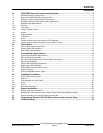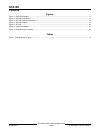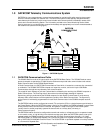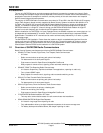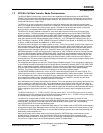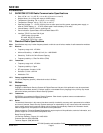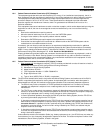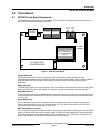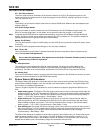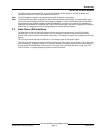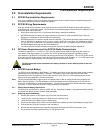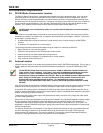
SC3100
Introduction
SC3100 Operation and Installation Guide
© 2004 Bosch Security Systems Page 7 90026-201D
1.3 SC3100, Full Data Transfer, Radio Communicator
The SC3100 Radio Communicator is a derivative of the capabilities and features found on the SAFECOM
SC4000. The SC3100 and the SC4000 share the same two-way communications characteristics and receiving-
and-sending functions of host alarm panel signals. However, the SC3100 is a non-UL Listed device and is not
configured with inputs or output relays.
The SC3100 is normally configured as a stand-alone device for interface with the customer's existing alarm
panel. It is located at a customer site; commercial or residential. The smaller physical dimensions of the SC3100
permits installation inside of many existing alarm panels. The antenna can be mounted directly on the alarm
panel enclosure, or remotely positioned for optimum radio reception and transmission.
The SC3100 is normally installed to Intercept all of the alarm panel signals from the host alarm panel (also
known as a dialer). The dialer message is then digitally encoded and sent to the Central Station SAFECOM
SC9000 computer via the SAFECOM network. When SAFECOM is installed, it is the primary means of alarm
panel communication (the phone line serves as the backup route). The SC3100 is capable of interfacing with
most alarm panels that use industry standard pulse formats (3+1, 4+2, FBI Superfast, Radionics Slow, etc.) or
Dual Tone Multiple Frequency, DTMF (ADEMCO Contact ID, ADEMCO High Speed, or ADEMCO 4+2 Express),
or SIA-R, or Radionics Modem and Modem IIe, or BFSK formats.
The SC3100 can be thought of as “a digital receiver in a box”, in that it has the ability to receive the signals from
the host alarm panel, and then generate an ACK and kissoff to the alarm panel, while sending the signal to the
Central Station SC9000 computer. The SC3100 sends all the necessary (ACK) tones to the host alarm panel in
response to the Dialer seizing the phone line. These ACK tones can be programmed at the Central Station
SAFECOM Computer to short and long durations, frequencies of 1400 or 2300 Hz, as well as low/high (Contact
ID) and the Bosch Security Systems D6500 Modem ACK. The SC3100 has the ability to emulate the following
digital receivers: ADEMCO 685, Bosch Security Systems D6500, Silent Knight, ADCOR, Veritech, Morse, and
ITI. In addition, the SC3100 can be programmed at the Central Station to send a 440 Hz tone to the Dialer to
simulate dial tone. This tone comes in two bursts lasting one second each, and is usually enough to satisfy alarm
panels that “sniff” the phone line for line fail.
The host alarm panel signals are sent to the Central Station SC9000 computer. Then, the signals are displayed
on the SC9000 computer and transferred to the Central Station's Automation Software (BOLD, SIS, SIMS, DICE,
MAS, or most industry standard software package). Primary routing of the digital alarm messages is conducted
along the SAFECOM network that exists between a SC3100 in the field and the Central Station SC9000
Receiver. The primary routing then moves the message to an automation software system.
The SAFECOM SC9000 computer can monitor all of the unique alarm panel signals from each SC3100. The
SC3100 functions strictly in a supervisory capacity when interfaced with an existing alarm system. The SC3100
is an intercept/delivery system which is designed for easy installation and interface with any alarm system. The
alarm panel dialer cable is simply connected to the SC3100 phone jack “DIALER” connector and the house
phone cable from the RJ31X jack, to the SC3100 RJ31X connector.
No modifications to the existing alarm system are required. The normal operation of the existing alarm panel and
security system is not affected in any way. The existing detectors and initiating circuits still report the status of
their circuits directly to the host alarm panel. When the host alarm panel goes to send a signal, it no longer uses
the phone line. The SAFECOM network is used to send all signals that will continue to be received at the Central
Station regardless of the phone line’s status. The house phones will normally not be interrupted by the alarm
panel.
The SC3100 requires an 11 - 15 VDC (12 VDC), 350 mA, power source. This 12 VDC power source is normally
provided by the auxiliary power terminal of the host alarm panel. However, an 11 -15 VDC auxiliary power supply
or external battery is an acceptable power source for the SC3100.
The SC3100 is configured with a 12VDC internal gel cell battery. This internal battery provides all of the
necessary peak current (ampere) requirements when the SAFECOM Radio Transceiver is transmitting (TX) and
receiving (RX). The Battery is mounted inside of the SC3100 Radio Communicator and is accessible by
removing the SC3100 cover and internal battery plate.
Each SC3100 is configured with a Fallback life safety feature. The Fallback mode of SAFECOM communications
ensures that all alarm event messages sent by the host alarm panel will be routed to the Central Station in case
of a SC3100 or SAFECOM network failure. It also provides the ability to perform alarm panel programming and
downloading via the telephone line.
Alarm panel signals are normally routed to the Central Station by SAFECOM radio communications as the
primary mode of transportation. In the event that the SC3100 cannot send the Dialer message via the
SAFECOM network because of some type of failure, the message is automatically routed to the backup phone
line and on to a digital receiver at the Central Monitoring Station (Fallback Mode).



